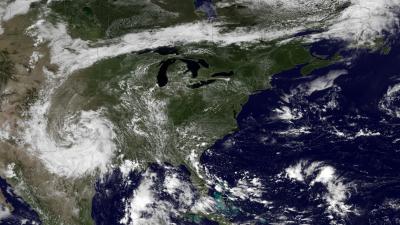Benchmarking the Community Land Model Over the Contiguous United States
Understanding the role of multiscale land surface processes in modulating regional weather and climate is critical for weather forecasting, drought monitoring, and flood forecasting. Researchers have used and continuously improved the Community Land Model (CLM) for decades. A multi-institutional research team employed various observational datasets to comprehensively evaluate the most recent version of CLM, now called the Community Terrestrial System Model (CTSM), over the Contiguous United States (CONUS). The study identified the enhancements in accuracy achieved by the recent structural and model parameterization updates. Overall, the updates improve CSTM’s ability to capture terrestrial biogeochemical dynamics, but future efforts need to improve streamflow simulations and incorporate spatially distributed vegetation parameters and agricultural management practices.
Researchers found general improvements in CTSM simulations of terrestrial biogeochemistry due to model improvements in biogeochemical parameterizations (e.g., accounting for carbon cost for nitrogen uptake), hydrology (e.g., spatially variable soil thickness, explicit simulation of saturated and unsaturated zones), and agricultural management practices. These result in an enhanced capability to capture interactions between surface and subsurface land surface processes, as well as energy and carbon cycles. However, the study revealed biases in simulating the magnitudes of energy, carbon, and water variables. These carbon flux biases mainly stem from shortcomings in modeling land management practices for crops, phenology and physiology parameters for trees and grasses, and hydrologic parameter values related to soil and hydrology.
Simulations of energy, water, and carbon cycles for hydrometeorological and hydroclimatological applications must be at fine spatial resolutions to sufficiently capture land surface changes and processes. An open-source community land model that has been widely used globally, CTSM had not been systematically assessed at the fine spatial scales necessary for high-resolution climate models and fully coupled Earth system model applications. This study constitutes the first attempt to comprehensively evaluate CTSM over the CONUS while adequately capturing land surface changes and processes. Researchers conducted simulations using three different CLM configurations: CLM5-biogeochemistry (CLM5BGC), CLM4.5BGC, and CLM5-satellite phenology (CLM5SP) at 0.125° over the CONUS during 1979 – 2018. They validated and compared the results against multiple remote-sensed and in situ datasets. Overall, the parametric and structural updates improved the model’s ability to capture terrestrial biogeochemical dynamics. The low evapotranspiration results in the CLM5BGC simulation are associated with biases in simulating vegetation phenological characteristics rather than soil water limitations. The inaccuracy in CLM5BGC-simulated peak leaf area index is attributable to CLM5BGC's inability to simulate tree and grass phenology. The disparity between CLM-simulated irrigation and reference estimates can be attributed to differences between the represented processes, as well as uncertainties in the input and validation datasets. Evaluation against small catchment observations suggests that hydrologic parameters need calibration to improve runoff simulations. Additional efforts are needed to incorporate spatially distributed plant phenology and physiology parameters along with regionally specific agricultural management practices.

